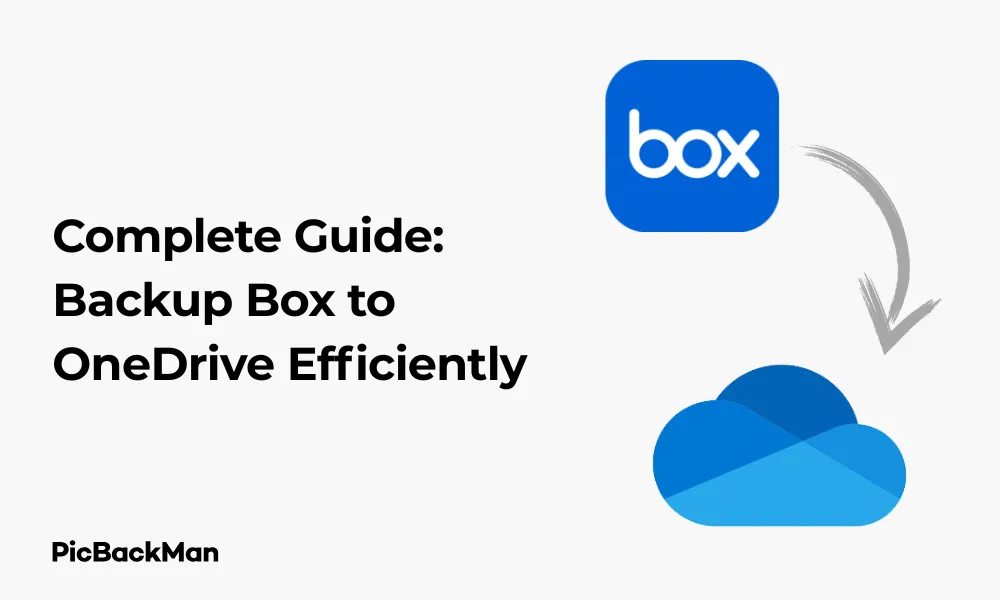
Why is it the #1 bulk uploader?
- Insanely fast!
- Maintains folder structure.
- 100% automated upload.
- Supports RAW files.
- Privacy default.
How can you get started?
Download PicBackMan and start free, then upgrade to annual or lifetime plan as per your needs. Join 100,000+ users who trust PicBackMan for keeping their precious memories safe in multiple online accounts.
“Your pictures are scattered. PicBackMan helps you bring order to your digital memories.”
Complete Guide: Backup Box to OneDrive Efficiently


Backing up your files from Box to OneDrive might seem challenging, but it's actually a straightforward process when you know the right steps. Whether you're switching cloud storage providers or just creating an extra backup, this guide will walk you through everything you need to efficiently transfer your files from Box to OneDrive.
I've helped many clients with this exact transition and compiled all the best methods in one comprehensive guide. By the end of this article, you'll be able to confidently move your data while keeping your folder structure intact and ensuring all your important files transfer correctly.
Why Backup Box to OneDrive?
Before diving into the how-to steps, let's quickly look at some reasons you might want to backup your Box files to OneDrive:
- Microsoft 365 integration if you use those tools regularly
- Creating redundant backups for important files
- Company transition from Box to Microsoft ecosystem
- Better collaboration features in OneDrive for your specific needs
- Cost savings depending on your subscription plans
Preparation Before Backup
Check Your Storage Limits
Before starting any backup process, you need to make sure you have enough space in your destination. OneDrive offers different storage limits based on your subscription:
| OneDrive Plan | Storage Limit |
|---|---|
| OneDrive Basic (Free) | 5GB |
| Microsoft 365 Personal | 1TB |
| Microsoft 365 Family | 6TB (1TB per person) |
| OneDrive for Business Plan 1 | 1TB |
| OneDrive for Business Plan 2 | Unlimited |
Organize Your Box Files
Take some time to clean up your Box account before the transfer:
- Delete unnecessary files to save transfer time
- Organize folders logically if they're currently messy
- Check for any duplicate files that don't need multiple copies
- Make note of any particularly important files to verify later
Method 1: Manual Download and Upload
The most straightforward method is to manually download your files from Box and then upload them to OneDrive.
Step-by-Step Process
Downloading from Box:
- Log into your Box account through a web browser
- Select the files or folders you want to backup
- Click "Download" from the top menu
- For multiple files, Box will compress them into a ZIP file
- Save the downloaded files to a location on your computer
Uploading to OneDrive:
- Log into your OneDrive account
- Navigate to the folder where you want to store your files
- Click "Upload" and select "Files" or "Folder" depending on what you're transferring
- Select the files/folders you downloaded from Box
- Wait for the upload to complete (time depends on file size and internet speed)
Pros and Cons of Manual Method
| Pros | Cons |
|---|---|
| No additional software needed | Time-consuming for large amounts of data |
| Complete control over what gets transferred | Requires stable internet connection throughout |
| Can organize files differently during transfer | Risk of forgetting files or losing folder structure |
| Good for small amounts of data | Requires computer storage as intermediary |
Method 2: Using Box Desktop Sync and OneDrive Sync
This method uses the desktop applications for both services to create a more streamlined process.
Setting Up the Desktop Apps
For Box:
- Download and install Box Drive from the Box website
- Sign in with your Box credentials
- Allow the application to sync your Box files to your computer
For OneDrive:
- Download and install the OneDrive app (comes pre-installed on many Windows systems)
- Sign in with your Microsoft account
- Set up the sync settings for your OneDrive account
Transferring Files
- Open File Explorer (Windows) or Finder (Mac)
- Navigate to your Box Drive folder
- Select all files and folders you want to transfer
- Copy them (Ctrl+C or Command+C)
- Navigate to your OneDrive folder
- Paste the files (Ctrl+V or Command+V)
- Wait for OneDrive to sync the files to the cloud
Monitoring Progress
You can monitor the upload progress by checking the OneDrive icon in your system tray (Windows) or menu bar (Mac). Clicking on it will show you sync status and any potential issues.
Method 3: Using Third-Party Transfer Services
Several third-party services can help automate the transfer process between cloud storage providers.
Popular Transfer Services
MultCloud
- Create a MultCloud account at multcloud.com
- Add your Box account under "Add Cloud" option
- Add your OneDrive account the same way
- Use the "Cloud Transfer" feature
- Select Box as the source and OneDrive as the destination
- Choose which files/folders to transfer
- Click "Transfer Now" to begin the process
CloudHQ
- Sign up for CloudHQ at cloudhq.net
- Connect both your Box and OneDrive accounts
- Set up a sync pair between Box and OneDrive
- Configure sync options (one-way sync is recommended for backup)
- Start the sync and monitor progress on the dashboard
Wondershare InClowdz
- Download and install InClowdz
- Create an account and log in
- Add both Box and OneDrive accounts
- Select "Migrate" option
- Choose Box as source and OneDrive as target
- Select files to migrate and start the process
Comparing Third-Party Services
| Service | Free Tier | Speed | Ease of Use | Special Features |
|---|---|---|---|---|
| MultCloud | Up to 30GB transfer | Medium | Very Easy | Schedule transfers, filter files |
| CloudHQ | Limited features | Fast | Moderate | Real-time sync, extensive logging |
| Wondershare InClowdz | Limited transfer amount | Fast | Easy | Management tools for multiple clouds |
Method 4: Using Microsoft Power Automate
If you're in a business environment, Microsoft Power Automate (formerly Flow) offers powerful automation capabilities for transferring files.
Setting Up Power Automate
- Go to flow.microsoft.com and sign in with your Microsoft account
- Click "Create" to make a new flow
- Select "Automated flow"
- Name your flow and choose a trigger (such as "When a file is created in Box")
- Connect your Box account when prompted
- Add an action step for "Create file in OneDrive"
- Connect your OneDrive account
- Configure the file details (use dynamic content from the trigger)
- Save and test your flow
Advanced Power Automate Options
For more comprehensive transfers, you can create more complex flows:
- Set up scheduled flows to run daily/weekly backups
- Add conditional logic to only transfer certain file types
- Include notification steps to alert you when transfers complete
- Create folder structures in OneDrive that match your Box organization
Handling Large Files and Folders
When dealing with particularly large amounts of data, special considerations are needed:
Breaking Down Large Transfers
Instead of trying to transfer everything at once, consider these approaches:
- Transfer folder by folder, starting with the most important
- Split very large folders into smaller subfolders
- Transfer files in batches based on type (documents, images, etc.)
- Schedule transfers during off-hours when your internet connection isn't being used heavily
Dealing with File Size Limits
Be aware of these size limits when transferring:
| Platform | File Size Limit |
|---|---|
| Box (upload via web) | Up to 5GB for free accounts, 15GB for paid |
| Box (using Box Drive) | Up to 15GB |
| OneDrive Personal | Up to 100GB per file |
| OneDrive for Business | Up to 250GB per file |
For files exceeding these limits, you may need to:
- Compress the files before transferring
- Split large files into smaller parts
- Use specialized large file transfer services
Maintaining File Permissions and Sharing
One challenge when transferring between cloud services is preserving access permissions and sharing settings.
Understanding Permission Differences
Box and OneDrive handle permissions differently:
- Box uses a combination of folder-level and file-level permissions
- OneDrive primarily uses sharing links and folder permissions
- Box has more granular permission controls in business accounts
- OneDrive integrates tightly with Microsoft 365 groups and SharePoint
Recreating Sharing Settings
- Document your current Box sharing settings before transfer
- Note which files are shared with specific people
- After transfer, manually set up similar sharing in OneDrive
- Use OneDrive's "Share" feature to send new links to collaborators
- Consider creating Microsoft 365 Groups for team folders
Verifying Your Backup
After completing the transfer, it's crucial to verify that everything moved correctly.
Checking File Integrity
- Compare file counts between Box and OneDrive
- Open a sample of files to ensure they transferred correctly
- Check that folder structures match your expectations
- Verify that file versions transferred if you need version history
- Ensure file modifications dates are preserved (if important to you)
Troubleshooting Common Issues
Missing Files
If files are missing after transfer:
- Check if they exceeded size limits
- Look for unsupported file types
- Verify they weren't in excluded folders
- Try transferring those specific files again
Corrupted Files
For files that don't open correctly after transfer:
- Download the original from Box again
- Try a different transfer method for those specific files
- Check if the file format is fully supported in OneDrive
Sync Errors
If using sync clients and experiencing errors:
- Check for filename restrictions (certain characters aren't allowed)
- Look for path length issues (Windows has a 260-character path limit)
- Restart the sync clients
- Verify your internet connection is stable
Maintaining Both Services During Transition
During a gradual transition, you might need to use both Box and OneDrive simultaneously.
Strategies for Dual-Service Period
- Decide which service will be the "source of truth" for each file type
- Create clear guidelines for team members about which service to use
- Consider using different services for different departments if needed
- Set a clear timeline for complete migration
Syncing Between Services
To keep both services in sync during transition:
- Use third-party sync tools like CloudHQ to maintain real-time syncing
- Set up automated flows to copy new files between services
- Create a schedule for manual syncing if automated options aren't available
- Train users on how to properly save to ensure files are in the right location
After the Backup: Maximizing OneDrive
Once you've successfully backed up your Box files to OneDrive, take advantage of OneDrive's features:
OneDrive-Specific Features
- Files On-Demand: Access cloud files without using local storage
- Microsoft 365 integration for editing documents directly
- Advanced sharing options with password protection
- Personal Vault for extra-secure files
- Photo recognition and search capabilities
Setting Up OneDrive Backup Features
Configure OneDrive to automatically back up important folders:
- Open OneDrive settings
- Go to the "Backup" tab
- Select "Manage backup"
- Choose which folders (Desktop, Documents, Pictures) to back up
- Click "Start backup" to begin the process
Security Considerations
When transferring data between cloud services, security should be a top priority.
Protecting Sensitive Data
- Encrypt highly sensitive files before transferring
- Consider transferring sensitive data using private networks
- Remove access to old files in Box after verifying the transfer
- Use strong passwords and two-factor authentication on both services
Compliance Considerations
If working with regulated data:
- Verify OneDrive meets your industry compliance requirements (HIPAA, GDPR, etc.)
- Document your transfer process for audit purposes
- Check data residency requirements if working internationally
- Consider using business or enterprise plans with advanced compliance features
Quick Tip to ensure your videos never go missing
Videos are precious memories and all of us never want to lose them to hard disk crashes or missing drives. PicBackMan is the easiest and simplest way to keep your videos safely backed up in one or more online accounts.
Simply download PicBackMan (it's free!), register your account, connect to your online store and tell PicBackMan where your videos are - PicBackMan does the rest, automatically. It bulk uploads all videos and keeps looking for new ones and uploads those too. You don't have to ever touch it.
Conclusion
Backing up your Box files to OneDrive doesn't have to be complicated. By following the methods outlined in this guide, you can efficiently transfer your data while maintaining organization and file integrity. Whether you choose the manual approach, desktop sync applications, third-party services, or Microsoft Power Automate, the key is to plan carefully, verify your transfers, and take advantage of OneDrive's features after migration.
Remember that the best approach depends on your specific situation – the amount of data you're transferring, your technical comfort level, and whether you're doing a one-time backup or a complete migration. Take your time to test your chosen method with a small batch of files before committing to a full transfer.
With your files safely backed up to OneDrive, you'll have the peace of mind that comes with redundant storage and the ability to access your important documents across all your devices.
Frequently Asked Questions
Can I keep my folder structure when transferring from Box to OneDrive?
Yes, all the methods described in this guide will maintain your folder structure during transfer. The desktop sync method and third-party transfer services are particularly good at preserving your exact folder hierarchy. Just make sure to transfer entire folders rather than individual files if maintaining structure is important to you.
How long does it typically take to transfer large amounts of data?
Transfer time depends primarily on your internet connection speed and the amount of data. As a rough estimate, with a good connection (100Mbps upload), you can transfer about 45GB per hour. For very large transfers (500GB+), expect the process to take several days. Using third-party services can be faster as they transfer directly between cloud services without using your bandwidth.
Will file version history transfer from Box to OneDrive?
Unfortunately, version history typically doesn't transfer between different cloud storage providers. When you move files from Box to OneDrive, you'll generally only get the current version. If version history is critical, you may need to manually download important previous versions and store them separately, or maintain access to your Box account for historical reference.
What happens to shared links when I move files from Box to OneDrive?
Shared links from Box will stop working once you move or delete the files from Box. You'll need to create new sharing links in OneDrive and distribute them to your collaborators. There's no automatic way to redirect old Box links to new OneDrive locations, so plan your communication with team members accordingly.
Is there a way to automate regular backups from Box to OneDrive?
Yes, you can set up automated regular backups using Microsoft Power Automate or third-party services like CloudHQ or MultCloud. These tools allow you to create scheduled sync jobs that can run daily, weekly, or at custom intervals. This is particularly useful if you need to maintain both services for an extended period and want to ensure your OneDrive backup stays current with Box changes.






